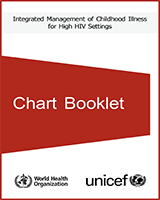All rights reserved. Publications of the World Health Organization can be obtained from WHO Press, World Health Organization, 20 Avenue Appia, 1211 Geneva 27, Switzerland (tel.: +41 22 791 3264; fax: +41 22 791 4857; e-mail: tni.ohw@sredrokoob). Requests for permission to reproduce or translate WHO publications – whether for sale or for noncommercial distribution – should be addressed to WHO Press, at the above address (fax: +41 22 791 4806; e-mail: tni.ohw@snoissimrep).
NCBI Bookshelf. A service of the National Library of Medicine, National Institutes of Health.
Overview
The IMCI chart booklet is a guide for first-level health workers on assessment, management and follow up of common childhood illnesses including pneumonia, malaria, diarrhoea, ear infections, severe malnutrition and measles. The modified IMCI chart booklet for high HIV settings addresses the same problems, including identification and management of HIV-related conditions such as skin and mouth conditions.
It has guidelines on HIV-exposed and infected infants and children on infant feeding, immunization, co-trimoxazole prophylaxis, Vitamin A, zinc and other micronutrient supplementation, as well as nutritional support. It provides general information on antiretroviral drugs for children, adherence to these drugs, side effects of these drugs and how to manage them.
Contents
- ACKNOWLEDGEMENTS
- CHILD AGED 2 MONTHS UP TO 5 YEARS ASSESS AND CLASSIFY THE SICK CHILD
- TREAT THE CHILD
- COUNSEL THE MOTHER
- Assess the Feeding of Sick Infants under 2 years (or if child has very low weight for age)
- Feeding recommendations during sickness and health
- Feeding advice for the mother of a child with confirmed HIV infection
- “AFASS” criteria for stopping breastfeeding for HIV exposed
- Counsel the mother about Stopping Breastfeeding (for HIV exposed)
- Counsel the mother about feeding problems
- Feeding recommendations: Child classified as HIV exposed
- Counsel the mother about her own health
- Advise the Mother to Increase Fluid During Illness
- Advise the mother when to return to health worker
- Advise mother when to return immediately
- ASSESS, CLASSIFY, AND TREAT THE SICK YOUNG INFANT AGED UP TO 2 MONTHS
- ANNEX A Skin and Mouth Conditions
- ANNEX B Antiretroviral therapy: Dosages
- ANNEX C Antiretroviral therapy: Side effects
- ANNEX D Drug dosages for opportunistic infections
- Recording Forms
- French
The designations employed and the presentation of the material in this publication do not imply the expression of any opinion whatsoever on the part of the World Health Organization concerning the legal status of any country, territory, city or area or of its authorities, or concerning the delimitation of its frontiers or boundaries. Dotted lines on maps represent approximate border lines for which there may not yet be full agreement.
The mention of specific companies or of certain manufacturers’ products does not imply that they are endorsed or recommended by the World Health Organization in preference to others of a similar nature that are not mentioned. Errors and omissions excepted, the names of proprietary products are distinguished by initial capital letters.
All reasonable precautions have been taken by the World Health Organization to verify the information contained in this publication. However, the published material is being distributed without warranty of any kind, either expressed or implied. The responsibility for the interpretation and use of the material lies with the reader. In no event shall the World Health Organization be liable for damages arising from its use.
- NLM CatalogRelated NLM Catalog Entries
- Evaluation of an algorithm for integrated management of childhood illness in an area of Kenya with high malaria transmission.[Bull World Health Organ. 1997]Evaluation of an algorithm for integrated management of childhood illness in an area of Kenya with high malaria transmission.Perkins BA, Zucker JR, Otieno J, Jafari HS, Paxton L, Redd SC, Nahlen BL, Schwartz B, Oloo AJ, Olango C, et al. Bull World Health Organ. 1997; 75 Suppl 1(Suppl 1):33-42.
- Performance of health workers after training in integrated management of childhood illness in Gondar, Ethiopia.[Bull World Health Organ. 1997]Performance of health workers after training in integrated management of childhood illness in Gondar, Ethiopia.Simoes EA, Desta T, Tessema T, Gerbresellassie T, Dagnew M, Gove S. Bull World Health Organ. 1997; 75 Suppl 1(Suppl 1):43-53.
- Evaluation of an algorithm for the integrated management of childhood illness in an area with seasonal malaria in the Gambia.[Bull World Health Organ. 1997]Evaluation of an algorithm for the integrated management of childhood illness in an area with seasonal malaria in the Gambia.Weber MW, Mulholland EK, Jaffar S, Troedsson H, Gove S, Greenwood BM. Bull World Health Organ. 1997; 75 Suppl 1(Suppl 1):25-32.
- Review Childhood pneumonia--progress and challenges.[S Afr Med J. 2006]Review Childhood pneumonia--progress and challenges.Zar HJ, Madhi SA. S Afr Med J. 2006 Sep; 96(9 Pt 2):890-900.
- Review Integrating HIV management for children into the Integrated Management of Childhood Illness guidelines.[Trans R Soc Trop Med Hyg. 2006]Review Integrating HIV management for children into the Integrated Management of Childhood Illness guidelines.Qazi SA, Muhe LM. Trans R Soc Trop Med Hyg. 2006 Jan; 100(1):10-3. Epub 2005 Oct 27.
- Integrated Management of Childhood Illness for High HIV SettingsIntegrated Management of Childhood Illness for High HIV Settings
Your browsing activity is empty.
Activity recording is turned off.
See more...
